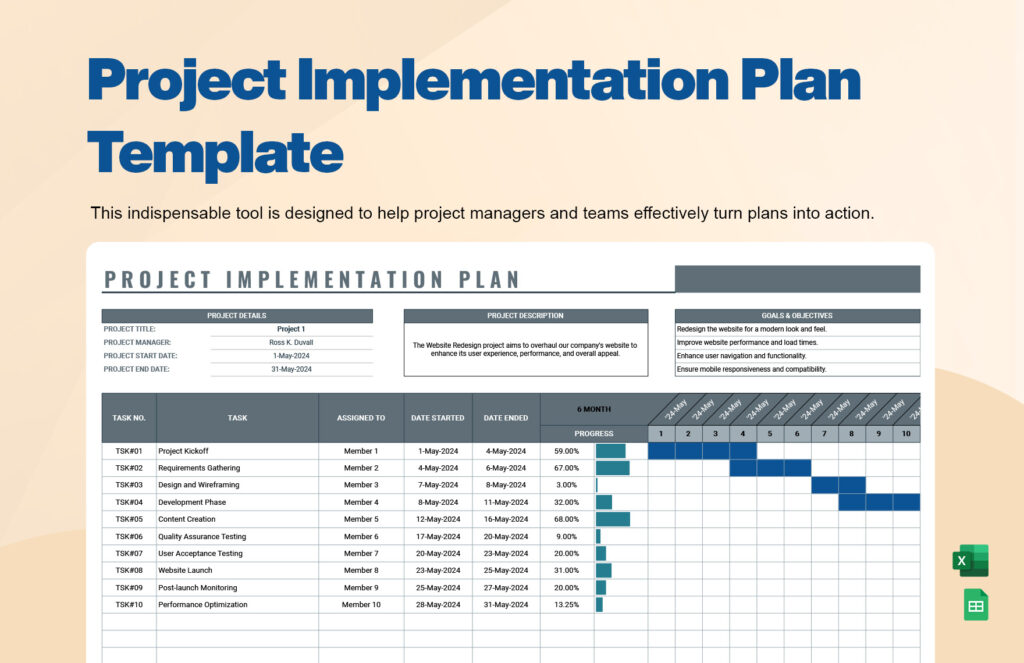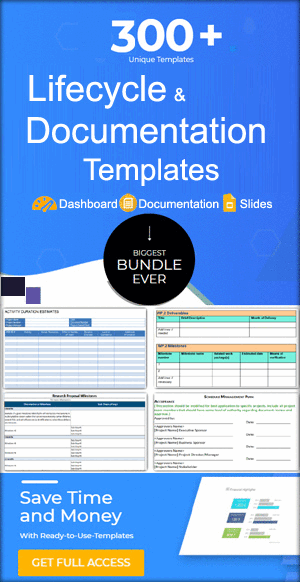Project Implementation Plan Template

A Project Implementation Plan Template ensures seamless execution by outlining key tasks, timelines, resources, and responsibilities. Available in Excel and Word formats, this structured document simplifies project tracking and risk mitigation. Using an implementation plan template, teams can improve efficiency, meet deadlines, and align efforts with business objectives. Whether managing a construction project or software deployment, this template optimizes workflows and accountability.

Introduction:
A project implementation plan is the backbone of successful execution. Without a structured plan, even the most promising projects can fail due to misalignment, resource shortages, and unforeseen risks. A project implementation plan template helps teams organize deliverables, assign responsibilities, and establish a timeline for completion. Whether using this template in Excel for data-driven tracking or a Word document for detailed documentation, the right approach guarantees a streamlined process.
Check out Change Management Plan Template in Excel as a Related Template.
What Is a Project Implementation Plan Template?
It is a structured document that defines project objectives, key deliverables, resource allocation, risk management, and performance tracking. It provides a roadmap to ensure all stakeholders understand their roles and responsibilities. This template eliminates confusion, improves coordination, and enhances overall efficiency.
A well-crafted implementation plan template includes:
- Project scope and objectives
- Task breakdown and timeline
- Resource allocation
- Risk management strategies
- Performance tracking and reporting
Using the excel template, project managers can track progress, monitor deadlines, and make data-driven decisions.
Related Article: Agile Project Planning
Key Components:
An effective implementation plan template consists of several core elements that ensure clarity and accountability.
1. Project Objectives & Scope
Clearly defining objectives ensures all stakeholders align their efforts. The project scope outlines deliverables, constraints, and expectations to prevent scope creep.
2. Task Breakdown & Timeline
A detailed Work Breakdown Structure (WBS) helps assign tasks and set realistic deadlines. This template offers visual tracking with Gantt charts and task dependencies.
3. Resource Allocation
Efficient allocation of human, financial, and material resources prevents bottlenecks and cost overruns.
4. Risk Management
Identifying potential risks and mitigation strategies keeps projects on track. A project implementation plan template word allows detailed documentation of risk analysis and contingency plans.
5. Performance Tracking & Reporting
Regular progress tracking ensures transparency. Excel templates provide real-time updates, while Word templates offer structured reports for stakeholder reviews.
Why Choose This Template?
Using this template improves project execution in multiple ways:
1. Improves Efficiency
Standardized processes reduce delays and improve productivity. An implementation plan template streamlines communication between teams.
2. Enhances Accountability
Assigning responsibilities eliminates ambiguity. A project implementation plan template word provides clear documentation for accountability.
3. Reduces Risks
A well-defined risk management section minimizes project failures. Project implementation plan template excel formats include risk matrices for proactive decision-making.
4. Simplifies Monitoring & Reporting
With structured tracking mechanisms, managers can assess progress and adjust strategies in real time.
Related Content: Project Quality Control Plan Template
How to Create?
Follow these steps to develop this comprehensive template:
1. Define Project Goals
Clarify objectives to ensure alignment with business needs.
2. Break Down Tasks & Assign Responsibilities
Use a WBS to structure tasks logically.
3. Develop a Timeline
Set realistic deadlines with milestone tracking.
4. Allocate Resources
Identify team members, budget, and materials required.
5. Identify Risks & Create Contingency Plans
List potential challenges and establish mitigation strategies.
6. Set Up Performance Metrics
Define KPIs to measure project success.
7. Monitor & Adjust
Use an Excel-based tracker to update progress regularly.
Check out project management action plan template as a related template.
Personal Experience:
I have personally used thistemplate, and it has transformed the way I manage projects. The structured format helps me break down tasks, set realistic deadlines, and track progress effortlessly. Whether using this template in Excel for real-time updates or a Word document for detailed reports, this tool has significantly improved my project execution. If you want a clear roadmap to keep your projects on track, I highly recommend using this template.
Related Article: project plan
Conclusion:
This template is a crucial tool for successful project execution. Whether using this template in excel format for dynamic tracking or in word format for documentation, the right approach ensures efficiency, accountability, and risk management. By leveraging a structured plan, teams can achieve project goals faster and more effectively.
Start using this template today to streamline workflows and drive project success!
FAQs:
Q.1 How do you write a project implementation plan?
To write a project implementation plan, define project goals, break down tasks, allocate resources, identify risks, set milestones, and track performance using an implementation plan template in Excel or Word.
Q.2 What are the 4 major components of an implementation plan?
The four major components are:
- Project objectives and scope
- Task breakdown and timeline
- Resource allocation
- Risk management and contingency planning
Q.3 How to make a project implementation plan in Excel?
Use a project implementation plan template excel to structure tasks, set deadlines, allocate resources, and track progress using Gantt charts and performance metrics.








